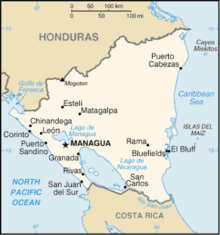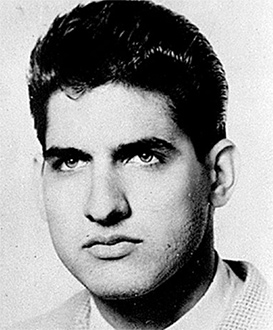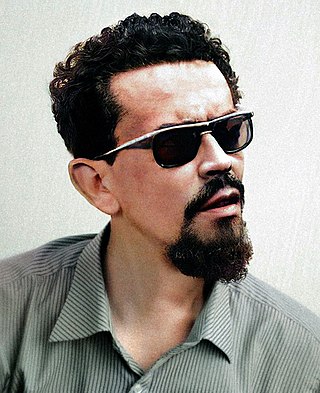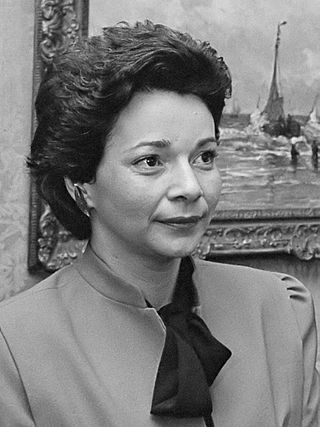
This is a bibliography of selected works about Nicaragua .

This is a bibliography of selected works about Nicaragua .

The Contras were the various U.S.-backed and funded right-wing rebel groups that were active from 1979 to 1990 in opposition to the Marxist Sandinista Junta of National Reconstruction Government in Nicaragua, which came to power in 1979 following the Nicaraguan Revolution. Among the separate contra groups, the Nicaraguan Democratic Force (FDN) emerged as the largest by far. In 1987, virtually all Contra organizations were united, at least nominally, into the Nicaraguan Resistance.

Nicaragua, officially the Republic of Nicaragua, is the largest country in Central America, bordered by Honduras to the north, the Caribbean to the east, Costa Rica to the south, and the Pacific Ocean to the west. Managua is the country's capital and largest city. As of 2015, it was estimated to be the third largest city in Central America. Nicaragua's multiethnic population of six million includes people of mestizo, Indigenous, European and African heritage. The main language is Spanish. Indigenous tribes on the Mosquito Coast speak their own languages and English.
Nicaragua is a nation in Central America. It is located about midway between Mexico and Colombia, bordered by Honduras to the north and Costa Rica to the south. Nicaragua ranges from the Caribbean Sea on the nation's east coast, and the Pacific Ocean bordering the west. Nicaragua also possesses a series of islands and cays located in the Caribbean Sea.

The Sandinista National Liberation Front is a socialist political party in Nicaragua. Its members are called Sandinistas in both English and Spanish. The party is named after Augusto César Sandino, who led the Nicaraguan resistance against the United States occupation of Nicaragua in the 1930s.

Hugo Spadafora Franco was an Italian and Panamanian physician and guerrilla fighter in Guinea-Bissau and Nicaragua. He criticized the military in Panama, which led to his murder by the government of Manuel Noriega in 1985.

Augusto C. Sandino, full name Augusto Nicolás Calderón Sandino, was a Nicaraguan revolutionary and leader of a rebellion between 1927 and 1933 against the United States occupation of Nicaragua. Despite being referred to as a "bandit" by the United States government, his exploits made him a hero throughout much of Latin America, where he became a symbol of resistance to American imperialism. Sandino drew units of the United States Marine Corps into an undeclared guerrilla war. The United States troops withdrew from the country in 1933 after overseeing the election and inauguration of President Juan Bautista Sacasa, who had returned from exile.

The Nicaraguan Revolution encompassed the rising opposition to the Somoza dictatorship in the 1960s and 1970s, the campaign led by the Sandinista National Liberation Front (FSLN) to oust the dictatorship in 1978–79, the subsequent efforts of the FSLN to govern Nicaragua from 1979 to 1990, and the Contra War, which was waged between the FSLN-led government of Nicaragua and the United States–backed Contras from 1981 to 1990. The revolution marked a significant period in the history of Nicaragua and revealed the country as one of the major proxy war battlegrounds of the Cold War, attracting much international attention.
Operation PBFortune, also known as Operation Fortune, was a covert United States operation to overthrow the democratically elected Guatemalan President Jacobo Árbenz in 1952. The operation was authorized by U.S. President Harry Truman and planned by the Central Intelligence Agency. The United Fruit Company had lobbied intensively for the overthrow because land reform initiated by Árbenz threatened its economic interests. The US also feared that the government of Árbenz was being influenced by communists.

Carlos Fonseca Amador was a Nicaraguan teacher, librarian and revolutionary who founded the Sandinista National Liberation Front (FSLN). Fonseca was later killed in the mountains of the Zelaya Department, Nicaragua, three years before the FSLN took power.
La Prensa is a Nicaraguan newspaper, with offices in the capital Managua. Its current daily circulation is placed at 42,000. Founded in 1926, in 1932 it was bought by Pedro Joaquín Chamorro Zelaya, who had become editor-in-chief. He promoted the Conservative Party of Nicaragua and became a voice of opposition to Juan Bautista Sacasa, for which the paper was censored. He continued to be critical of dictator Anastasio Somoza García, who came to power in a coup d'état.

Nora Josefina Astorga Gadea de Jenkins was a Nicaraguan guerrilla fighter in the Nicaraguan Revolution, a lawyer, politician, judge and the Nicaraguan ambassador to the United Nations from 1986 to 1988.
Sandinista ideology or Sandinismo is a series of political and economic philosophies instituted by the Nicaraguan Sandinista National Liberation Front throughout the late twentieth century. The ideology and movement acquired its name, image and its military style from Augusto César Sandino, a Nicaraguan revolutionary leader who waged a guerrilla war against the United States Marines and the conservative Somoza National Guards in the early twentieth century. The principals of modern Sandinista ideology were mainly developed by Carlos Fonseca, inspired by the leaders of the Cuban Revolution in the 1950s. It sought to inspire socialist populism among Nicaragua's peasant population. One of these main philosophies involved the institution of an educational system that would free the population from the perceived historical fallacies spread by the ruling Somoza family. By awakening political thought among the people, proponents of Sandinista ideology believed that human resources would be available to not only execute a guerrilla war against the Somoza regime but also build a society resistant to economic and military intervention imposed by foreign entities.

Arturo José Cruz Porras, sometimes called Arturo Cruz Sr. to distinguish him from his son, was a Nicaraguan banker and technocrat. He became prominent in politics during the Sandinista (FSLN) era. After repeatedly resigning from positions in protest, opinion divided between those who lauded him as a statesman and man of principle, and those who derided him as an ineffectual hand-wringer.

Nicaragua–Russia relations are the bilateral relations between Russia and Nicaragua.
General elections were held in Nicaragua on 25 February 1990 to elect the President and the members of the National Assembly. The result was a victory for the National Opposition Union (UNO), whose presidential candidate Violeta Chamorro surprisingly defeated incumbent president Daniel Ortega of the Sandinista National Liberation Front (FSLN). This led to a historic peaceful and democratic transfer of power in Nicaragua.
In 1979, the Sandinista National Liberation Front (FSLN) overthrew Anastasio Somoza Debayle, ending the Somoza dynasty, and established a revolutionary government in Nicaragua. Following their seizure of power, the Sandinistas ruled the country first as part of a Junta of National Reconstruction. Following the resignation of centrist members from this Junta, the FSLN took exclusive power in March 1981.
In the decade of Sandinista rule following the triumph of the Nicaraguan Revolution in 1979, close to 300 murals were created in that country. These murals provided a narrative of the revolution, portraying recent and more distant history, and visualizing the better future promised by the revolution.
Shirley Christian is a Pulitzer Prize-winning journalist and author, known for reporting on the Central American crisis during the 1970s and 1980s. Christian has worked as a foreign correspondent for the New York Times, Miami Herald, and Associated Press. Her book on the Nicaraguan Revolution, according to the Wall Street Journal, “may stand as the definitive account of the fall of Anastasio Somoza and the rise of the Sandinistas.”
Anarchism in Nicaragua emerged during the United States occupation of Nicaragua, when the workers' movement was first organized against the interests of foreign capital. This led to a synthesis of Latin American anarchism with the goals of national liberation, which influenced the early Sandinista movement.